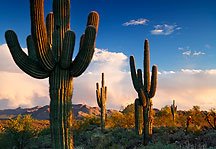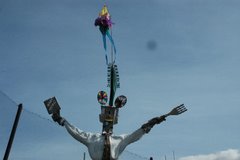 Q: What does an emu do?
Q: What does an emu do?A: Not much. But when it comes towards you, the ground shakes.
-- Neil YoungThere's always new shtick growing in the garden for your daily dose of roughage!

Many critics out there have referred to his music as cornball or too mellow, and some of you may feel the same—and that’s okay—but in my opinion he’s a prophet for his stance on environmental issues.
He was a man ahead of his time, who embraced environmental causes way before many of us even understood what environmentalism is.
John Denver introduced me to the environment through his music.
In particular, he exposed me to the stories of the beauty and majesty of the Colorado Rocky Mountains; a place which, shamefully, I still have yet to visit and explore. I'll get there someday physically, as I visit the place every time I put his music on.
 My first exposure to
My first exposure to
...oh excuse me, my first record was one by Burl Ives, and it WASN'T the one with "Frosty the Snowman."
Yikes!
The most intriguing part of
Looking back, I think I "got it" even at the age of 6... I guess I figured it's a no-brainer. Protect the planet to ensure it's longevity.
Duh.
 What’s so funny about all this is the fact that my mother, who once stated that “she has no connection with nature,” and is the only person I know who refuses to recycle—essentially representing the opposite of everything I value in this world—is the exact individual who pushed the music of John Denver on me as a child. That’s what planted a seed for a big part of the belief system, and the stewardship for the environment, that I carry around to this day.
What’s so funny about all this is the fact that my mother, who once stated that “she has no connection with nature,” and is the only person I know who refuses to recycle—essentially representing the opposite of everything I value in this world—is the exact individual who pushed the music of John Denver on me as a child. That’s what planted a seed for a big part of the belief system, and the stewardship for the environment, that I carry around to this day.
Damn it, I digressed again... somebody stop me.
Shifting gears, this month marks the 10-year anniversary of his untimely death in 1997, when he died piloting an experimental Long-EZ aircraft which crashed just after takeoff from the
After establishing his musical career in the mid 1970s,
 environmental education. You can visit their website here: John Denver's Windstar Foundation. Check out the site and offer some support!
environmental education. You can visit their website here: John Denver's Windstar Foundation. Check out the site and offer some support!
If you ever want to know any detail of what was on
So the story goes… thank you, John Denver, for the inspiration and example you set. S
 Well, it just so happens that something interesting is happening with the ball that Bonds broke the record with---check this out!
Well, it just so happens that something interesting is happening with the ball that Bonds broke the record with---check this out!After more than 10 million online votes, 47 percent of voters wanted the ball to be adorned with an asterisk, 34 percent said it should not be changed and 19 percent wanted it to be shot into space. The first two options included the addendum that the ball would be donated to the Hall of Fame.
While representatives of the Hall were thrilled to get the ball from the most hallowed record in sports, they said their acceptance of the asterisk-laden piece of history did not mean that they supported the inference that Bonds used performance-enhancing substances to achieve his home run total.
"As far as we're concerned, the asterisk represents the voices of the fans for this one moment in time," said Jeff Idelson, the Hall's vice president for communications and education. "For this one week, in September of 2007, this is what the fans wanted. We felt it was worth it to take it."
By accepting Ecko's soon-to-be branded donation, the Hall, which operates independent of Major League Baseball, has put itself in the unusual position of taking, and then displaying, a ball that has been defaced. Idelson said that the Hall "does not support the defacing of artifacts," but that this ball was too monumental to ignore.
Absolutely poetic---I couldn't have imagined a more perfect ending to an otherwise despicable situation. ...and it was brought to you in Giant orange even... ...with a little Mariner blue too... S





